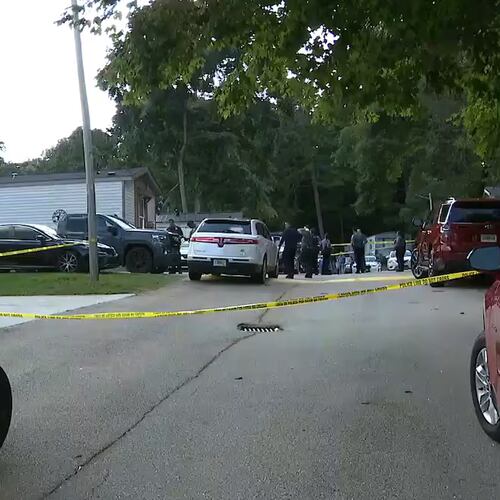The killing of Jose Ignacio Escobedo didn't splash across the headlines like the deaths of Russell Sneiderman or Dorothy and Roger Abbott. After all, Sneiderman was gunned down outside a daycare center, and the Abbotts were slain inside their Dunwoody home. Escobedo's body turned up in a Sandy Springs dumpster.
But police have determined that Escobedo, 34, like the others was killed in Dunwoody. That brings to four the number of unsolved homicides in a city incorporated partly on the promise that having its own police department would make residents safer.
Nothing links the four killings, and neither authorities nor residents regard them as a reason for the people of Dunwoody to live in fear. Nevertheless, the fledgling city’s six police detectives have their hands full.
“Certainly, there is pressure to bring some closure,” police Chief Billy Grogan said. “But these incidents are not related, so there’s no need to believe that Dunwoody is not safe.”
The first killings came to light the morning of July 1 with a fire at the Abbott’s Peeler Road home. The rubble yielded the remains of Roger and Dorothy Abbott, 82 and 78, respectively, and investigators determined that they had been killed by human hands, not smoke or flames.
The fire, police say, was set in an attempt to conceal the true nature of their deaths.
Escobedo’s body was found July 13. Police later got a tip that he had been shot and killed six miles away at the Parkwood Village apartments on Winter’s Chapel, in Dunwoody’s southeastern-most corner.
And last month, Sneiderman, 36, was shot four times in the parking lot of the preschool where he’d just dropped off his son, 2.
Police described the Nov. 18 slaying as a “cold, calculated murder” committed by a man able to shoot Sneiderman multiple times in broad daylight, then vanish into morning traffic.
Investigations continue in each case, but police haven't hinted at any clues as to motives, and they haven't revealed the exact cause of the Abbotts' deaths.
Authorities believe the killings do have one thing in common -- with each other and with most cases of homicide: “The people who did this, they knew their victims,” Grogan said.
One of the promised benefits of Dunwoody's founding was a local police forced dedicated solely to protecting and serving the more than 33,000 people who call the 21-month-old city home.
But meeting the demands of crime-fighting in a suburb can be tricky, Grogan said.
“Just because we have the Dunwoody Police Department doesn’t mean crime is going to disappear,” he said.
Residents seem to get that.
“They can’t stop murders,” Bruce Boermer said of police. “All they can do is solve them.”
Lead detective Sgt. Gary Cortillino, a 30-year veteran of the DeKalb County police who retired as a lieutenant and joined the Dunwoody force, said the murder count is on pace for what the area typically experienced before cityhood.
“In this area, we usually ran maybe three to four homicides a year,” Cortillino said.
So there has been a mixed review of what the community’s new stature as a city has garnered for citizens.
“We definitely see a greater police presence,” said Wido Handoko, who lives within a mile of the Abbotts' home. “Maybe a patrol car will come by every two hours or so. But we only started seeing that after the fire.”
Handoko, a six-year resident, is unfazed by the open murder cases.
“I feel safer,” he said of current policing.
Ron Miller, Handoko’s neighbor, said he was neither for nor against cityhood, and he feels about as secure as he’s felt the 16 years he’s lived in Dunwoody.
“I don’t really believe the quality of policing has changed,” Miller said. “DeKalb police didn’t do any better or any worse than Dunwoody police are doing.”
The department was created in April 2008, after a campaign in which supporters of incorporation promised an increase in police patrols. They said five officers would be on duty at all times, as opposed to three when Dunwoody was under DeKalb’s jurisdiction.
"What we have ended up with is a police force that is visible, sharp, collaborative with the community, and has been widely praised and cheered by residents and businesses alike," Mayor Ken Wright said.
Grogan said the majority of crimes in the city are what he calls “crimes of opportunity” -- mostly theft from parked cars.
Mike Sullivan, a 37-year resident of Dunwoody’s Happy Hollow neighborhood, said the increase in patrols has been a help.
“I personally feel secure,” Sullivan said. “The homicides, to me, just show the changing times.”
Lead detective Cortillino similarly suggested that growth in the area may have contributed to crime.
“I think the population is growing,” he said. “The majority of these apartments pretty much popped up overnight, and I think the economy has created a transient population.”
The Abbotts’ home is less than a half-mile from Shallowford Road, one of the city's high-crime areas with a cluster of apartments and small shops.
Police have made some headway in each of the cases.
They seem to be farthest from a solution to Sneiderman’s death, even though there were witnesses and surveillance footage from cameras near the daycare center. Based on that information, police have released a composite sketch, which has been circulated throughout the media and area police agencies.
Dunwoody police also have released a composite sketch and description of a man seen at the Abbott’s home the morning of the fire. They say they have identified a person of interest in those slayings.
In the case of Jose Escobedo, the tip that led police to the location of the killing also led to the arrest of 25-year-old Jose Luis Sanchez. He was charged with concealing a death and tampering with evidence and is being held on $200,000 bail in the DeKalb County Jail.
About the Author
The Latest
Featured

